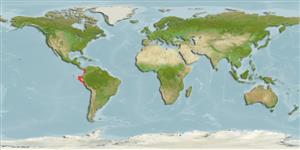Classification / Names
Common names | Synonyms | Catalog of Fishes (gen., sp.) | ITIS | CoL | WoRMS | Cloffa
Actinopterygii (ray-finned fishes) >
Lophiiformes (Anglerfishes) >
Oneirodidae (Dreamers)
Etymology: Chaenophryne: Greek, 'chaeno' or 'chaino' = to gape + Greek, 'phryne' = toad (alluring to a "gaping toad") (Ref. 86949). More on author: Regan, Trewavas.
Environment / Climate / Range
Ecology
Marine; bathypelagic; depth range ? - 1250 m (Ref. 58018), usually 300 - 1000 m (Ref. 86949). Deep-water, preferred ?; 9°N - 13°S, 140°E - 78°W
Western Central Pacific: Papua New Guinea. Eastern Central Pacific: Gulf of Panama.
Size / Weight / Age
Maturity: Lm ? range ? - ? cm
Max length : 10.2 cm SL male/unsexed; (Ref. 75756)
Dorsal
soft rays
(total): 6-8;
Anal
soft rays: 5 - 6. Distinguishing characteristics of metamorphosed female: esca with single elongate internally pigmented anterior appendage, less than one-fourth to nearly one-third length of escal bulb; absence of medial escal appendages; posterior escal appendages with swollen basal portion and compressed distal crest, posterior filament or filaments and pair of anterior lobes each with numerous filaments; filamentous anterolateral escal appendage on each side; absence of basal series of filaments; total number of teeth in upper jaw 21-45, lower jaw with 26-42 teeth; ratio between number of teeth in upper jaw to lower jaw teeth 0.78-1.30; vomerine teeth 4-7; length of illicium 20.1-41.3% SL; escal bulb width 2.1-6.3% SL (Ref. 86949).
Life cycle and mating behavior
Maturity | Reproduction | Spawning | Eggs | Fecundity | Larvae
Kailola, P.J., 1987. The fishes of Papua New Guinea. A revised and annotated checklist. Vol. 1. Myxinidae to Synbranchidae. Research Bulletin No. 41. Department of Fisheries and Marine Resources, Port Moresby, Papua New Guinea. 194 p. (Ref. 6993)
IUCN Red List Status (Ref. 115185)
CITES (Ref. 94142)
Not Evaluated
Threat to humans
Harmless
Human uses
More information
Common namesSynonymsMetabolismPredatorsEcotoxicologyReproductionMaturitySpawningFecundityEggsEgg development
ReferencesAquacultureAquaculture profileStrainsGeneticsAllele frequenciesHeritabilityDiseasesProcessingMass conversion
Tools
Special reports
Download XML
Internet sources
